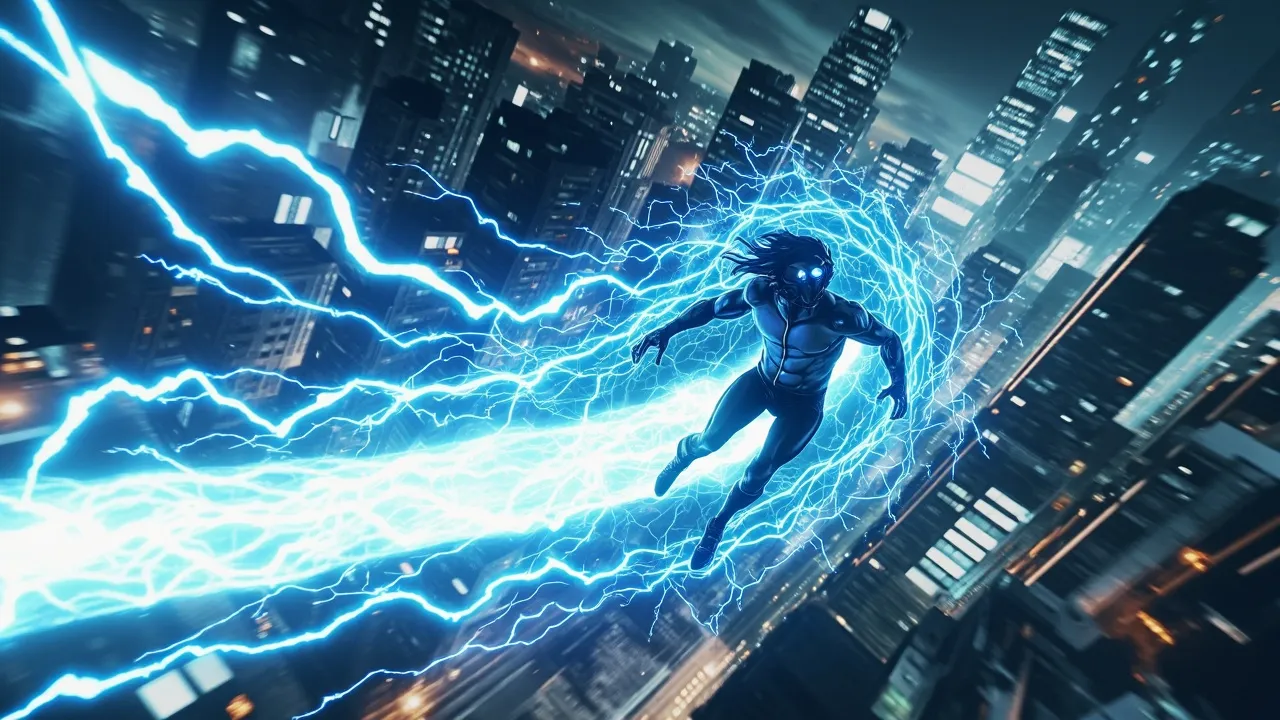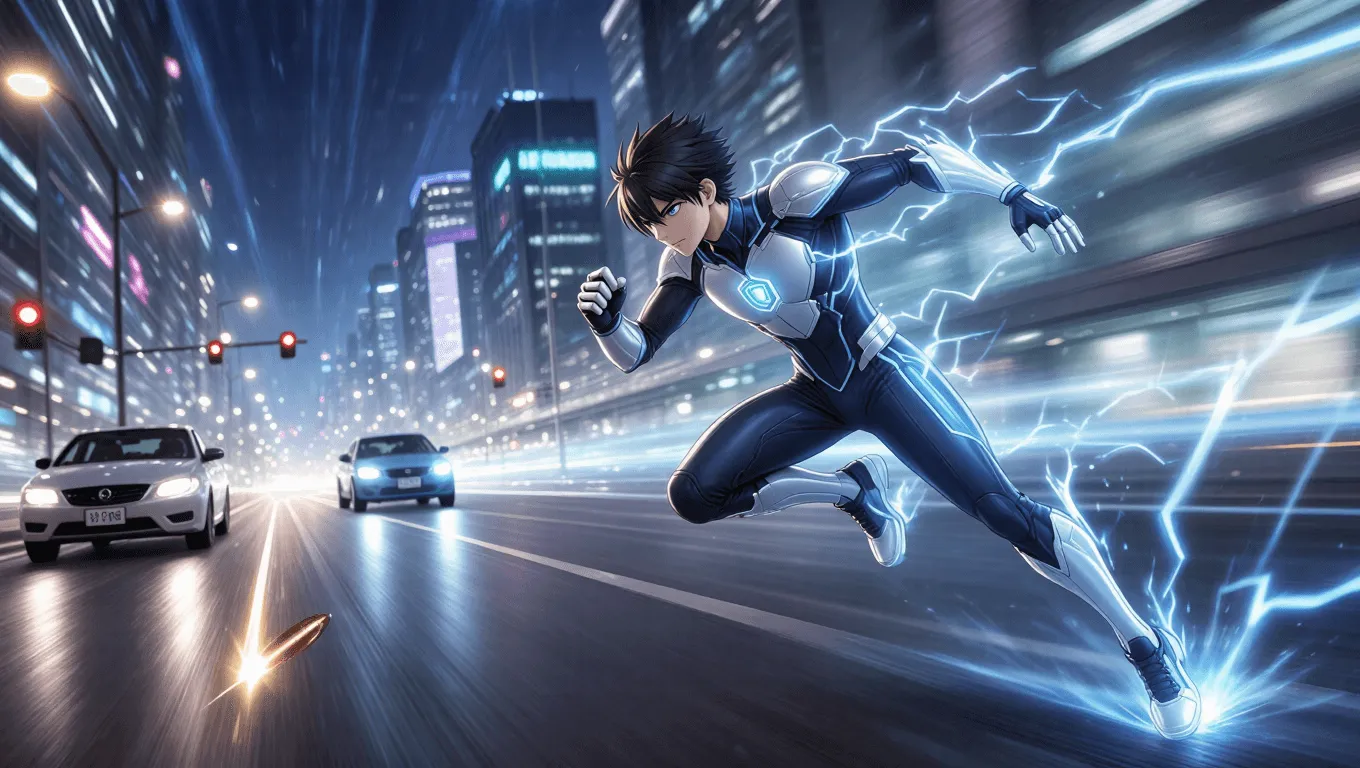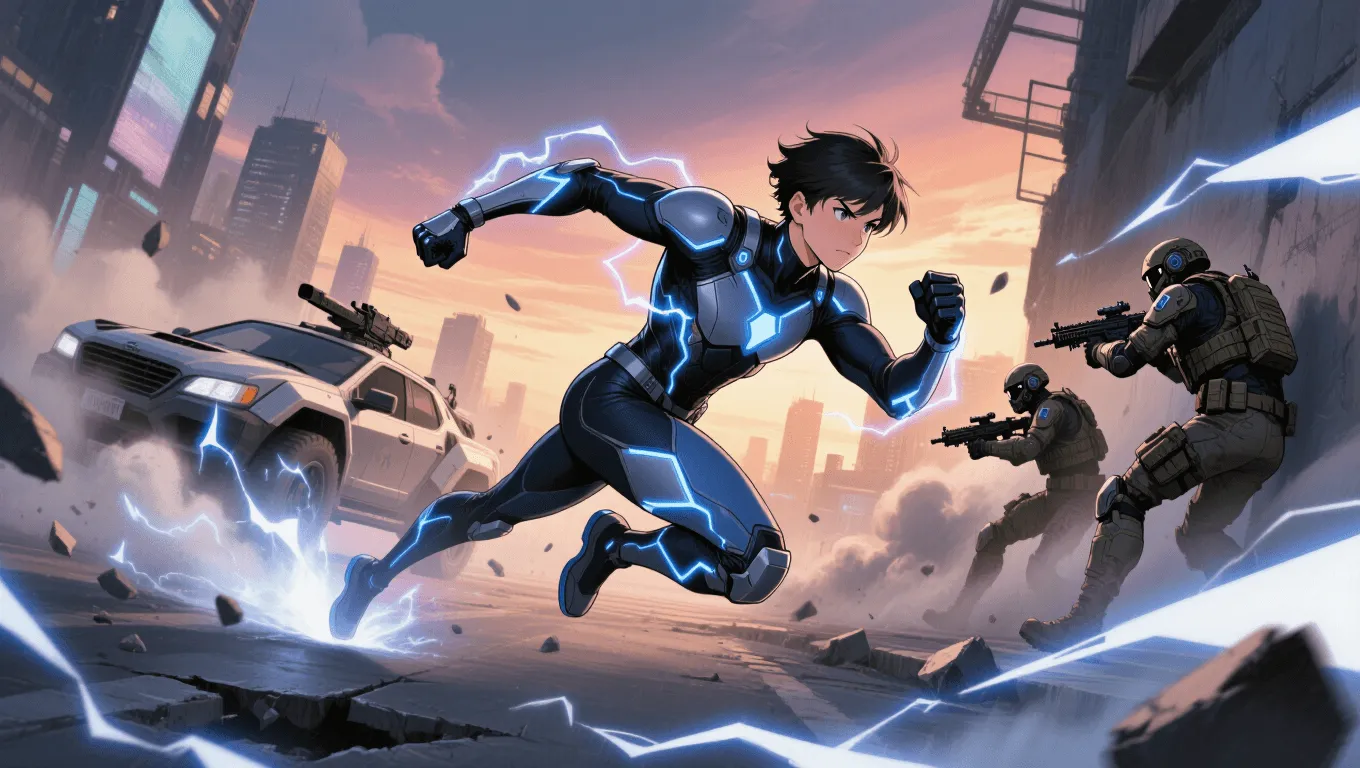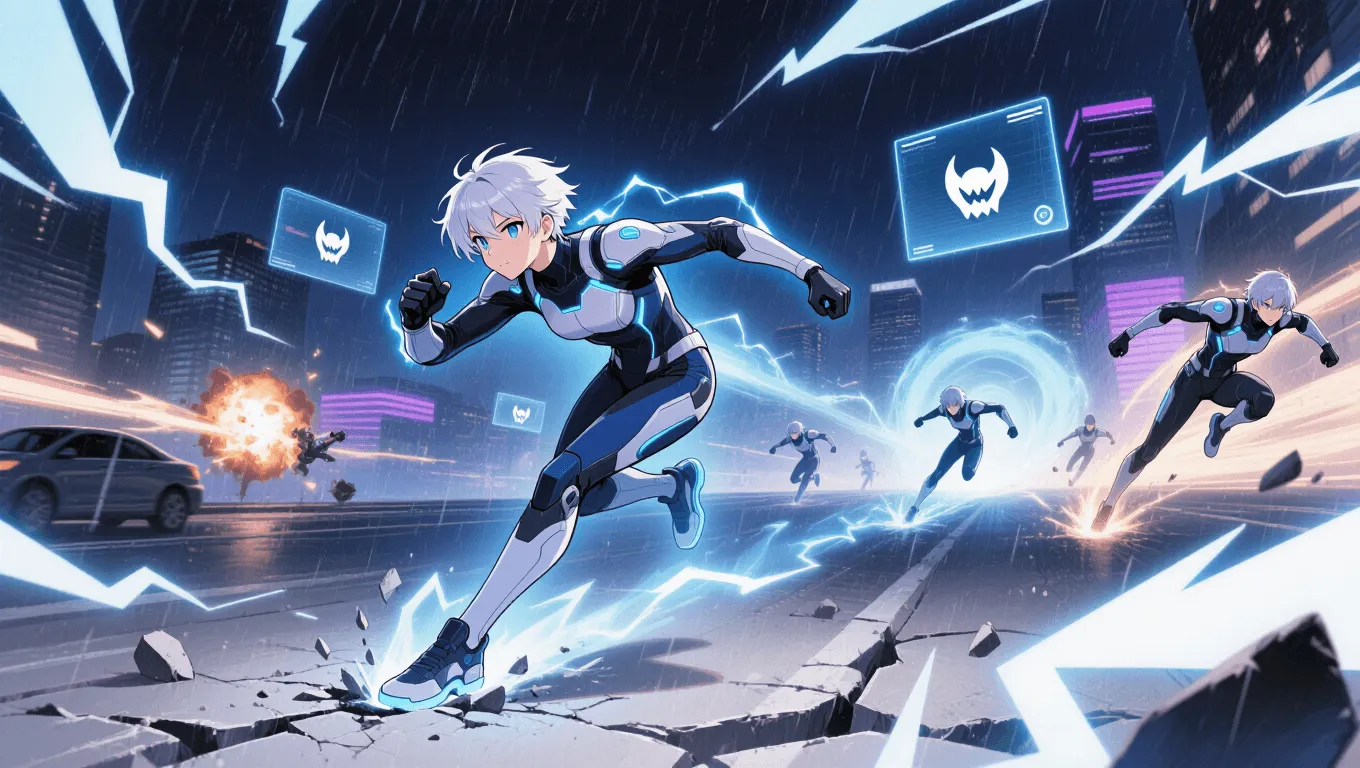Lightning Speed

Lightning Speed Video Demo 🎬
Table of Contents
What Is Lightning Speed
Lightning speed is the power to move, react, and process information at astonishing velocities that surpass natural limits. In many fictional settings, the user appears as a living blur, tracing crackling arcs of energy while crossing a city in seconds. Beyond simple running, this superhuman speed encompasses accelerated perception, rapid decision-making, and precision control of momentum. It turns traversal, evasion, and offense into a single fluid discipline—one where distance shrinks, threats slow down, and timing becomes the ultimate weapon.
Curious about other powers? Browse the full superpower wiki or spark inspiration with the random superpower generator.
Core Abilities of Lightning Speed
-
Superhuman locomotion: Sprinting across streets, oceans, or vertical surfaces by converting forward momentum into brief wall runs or water skims. Skilled users can reach supersonic or even hypersonic ranges, producing sonic booms and pressure wakes.
-
Accelerated reflexes: Reaction time compresses so dramatically that incoming projectiles, blades, or energy beams seem sluggish. This makes precision dodging and counterstrikes second nature.
-
Enhanced perception and cognition: Situational awareness scales with velocity. In high-focus states, the environment appears to stretch—sometimes compared to localized time dilation—allowing micro-adjustments during complex maneuvers.
-
Kinetic strikes: Speed translates into impact. A light jab delivered at high velocity can hit with bone-rattling force, while a shoulder check becomes a crowd-clearing battering ram. Running tackles and drop-kicks turn into devastating finishers.
-
Vibrational phasing: Advanced users can micro-vibrate their molecules to slip through thin barriers, loosen restraints, or negate certain solid obstacles. In narrative terms, this often requires intense control to avoid catastrophic missteps.
-
Tornado-generation and shockwaves: Rapid circular motion can whip up localized whirlwinds, disperse gas clouds, or throw foes off balance. Sudden stops or claps can produce concussive blasts.
-
Precision traversal: Parkour-like agility at scale—dashing along girders, ricocheting off walls, threading traffic, and weaving through shifting battle lines without losing momentum.
-
Speed mirages and afterimages: Quick feints leave visual echoes that confuse targeting systems and human opponents alike, opening windows for flanking maneuvers.
Application / Tactical Advantages in Combat
Lightning speed rewrites battlefield geometry:
-
Tempo control: The speedster dictates engagement range, choosing when to enter, strike, and disengage. This tempo advantage denies enemies time to coordinate or deploy heavy weapons.
-
Target isolation: By crossing space instantly, the user can split apart formations, pick off medics or commanders, and return before frontline units react.
-
Counter-sniper utility: Long sightlines normally aid snipers; speed collapses those sightlines, turning “far away” into “immediately reachable.”
-
Precision disarmament: With accelerated perception, weapons can be removed or disabled—magazines ejected, power cells pulled, safeties engaged—before a trigger is squeezed.
-
Crowd rescue and extraction: Evacuating civilians, moving wounded allies to safety, or repositioning critical equipment becomes far faster than any vehicle-based option.
-
Environmental manipulation: Rapid laps around a blaze deprive it of oxygen; quick sandbag placement blocks floodwater; controlled whirlwinds disperse tear gas or smoke to restore visibility.
In short, this power makes the user a strategic problem for any opponent who relies on distance, setup time, or concentrated firepower.
Level: Level 1 🏙️, Level 2 🌇, Level 3 🌃
Level 1 🏙️
At entry level, the speedster can outrun vehicles, scaling from 60–200 km/h with short bursts higher when adrenaline spikes. Reflexes are sharpened, granting reliable bullet-dodging at long range (where travel time is greater) and rapid sidestepping in melee. Endurance is limited: too many long sprints cause lactic buildup and overheating. Precision is solid, but anything like phasing or cyclonic effects is risky. This stage is ideal for quick rescues, scouting, and hit-and-run strikes—especially against foes who telegraph their moves.

Key milestones at this level:
-
Safely navigating busy streets without collisions.
-
Executing three to five disarm attempts in a single dash.
-
Maintaining situational awareness while changing directions rapidly.
Level 2 🌇
Now the user breaks the sound barrier—brief supersonic movement is feasible, with controlled acceleration and safer deceleration. Accelerated perception greatly expands, making multi-foe engagements routine. Momentum-based attacks can flip armored vehicles or crater walls. Controlled vortexes disperse smoke or pin unshielded enemies. With training, short phasing attempts become possible under calm conditions.

Key milestones at this level:
-
Consistent bullet-time perception even at close range.
-
Controlled vortex creation that doesn’t endanger allies.
-
Tactical rescues of multiple civilians within a single engagement cycle.
Level 3 🌃
At mastery, the speedster skirts relativistic edges in fiction, turning continents into commutes and battlefields into puzzles. Phasing becomes deliberate and repeatable; high-frequency vibrations allow bypassing many physical barriers. The user shapes airflow, pressure, and kinetic cascades to craft shockwaves or to nullify incoming explosive force by redirecting overpressure. Cognitively, the speedster can track dozens of moving elements, prioritize threats, and route optimal paths in microseconds.

Key milestones at this level:
-
Reliable phasing through complex materials.
-
Hypersonic traversal with precise braking and minimal collateral.
-
Real-time orchestration of multi-theater operations—disabling artillery, rescuing hostages, and sabotaging logistics in one continuous run.
Limitations of Using the Lightning Speed
-
Metabolic and thermal strain: Moving fast burns calories faster. Without enhanced physiology, core temperature spikes, dehydration sets in, and endurance collapses. Cooling gear, electrolyte gels, and high-density nutrition help.
-
Friction and air resistance: At high speeds, air acts like a wall; unprotected skin and eyes suffer. Specialized suits reduce drag and prevent wind shear injuries; helmets or goggles protect the cornea.
-
Inertial hazards: Speed is only useful if it can be redirected safely. Sudden turns risk joint damage or catastrophic skids; misjudged stops can injure the user or bystanders. Training focuses on controlled arcs, braking steps, and anchor points.
-
Situational tunnel vision: Hyper-focus can cause missed cues outside the “racing line.” Teams should designate a spotter or HUD overlays to surface off-angle threats, mines, or trip lasers.
-
Environmental sensitivity: Rain, ice, oil slicks, or dense debris fields drastically increase risk. Even a small bolt on the ground can become shrapnel at Mach speeds.
-
Cognitive overload: Perceiving more information faster can lead to decision fatigue. Tactical routines and playbooks keep choices simple under stress.
-
Collateral risk: Shockwaves, vortexes, and debris clouds can endanger allies. Mastery requires strict rules of engagement and pre-cleared paths.
Weakness Against What Other Superpowers
-
Temporal control: Time slow or stop removes the speedster’s core edge. Even partial dampening of local time flow can make sprinting impractical.
-
Gravity manipulation: Increased gravity pins the user, drains momentum, and makes acceleration wasteful. Directional gravity wells can also deflect the user into traps.
-
Spatial anchors and force fields: Barriers that can’t be bypassed by phasing force the user to brake or divert, buying enemies time.
-
Precognition: If an opponent anticipates routes and strike timings, the advantage narrows. Predictive targeting and auto-aim turrets fed by precogs are especially dangerous.
-
Mind control and illusions: Interfering with perception or intent derails otherwise perfect execution. False paths, phantom obstacles, or compelled hesitations can be devastating.
-
Electromagnetic disruption: Speed suits and HUDs can be scrambled, removing vital targeting, mapping, and cooling assistance.
Synergistic Power Combos
-
Electrokinesis: Channel frictional charge or ambient fields into directed blasts, taser-like palm strikes, or EMP bursts during high-speed passes.
-
Enhanced durability: Reinforced bones, shock-absorbing tissues, or kinetic dampeners allow riskier maneuvers and harder impacts without injury.
-
Super strength: Add raw force to velocity for unstoppable tackles, ground-pound shockwaves, or throwing heavy objects with pinpoint accuracy.
-
Teleportation (short hops): Blink past choke points or inside sealed rooms to start a run from optimal angles, then chain into speed-based combos.
-
Spatial awareness/clairvoyance: Live mapping of enemy positions and hazards lets the speedster weave through complex battlefields without slowing down.
-
Technopathy: Real-time hacking during a dash—locking doors behind foes, switching off turrets, or toggling elevators to reroute enemies.
-
Healing factor: Rapid recovery mitigates microtears, heat rash, and joint stress that come with heavy training and frequent high-velocity engagements.
Known Users
-
The Flash (DC Comics) — A premier speedster known for tapping into the Speed Force; see more on Barry Allen.
-
Quicksilver (Marvel Comics) — Mutant runner famed for supersonic reflexes; learn about Pietro Maximoff.
-
Dash Parr (The Incredibles) — A young hero whose quickness evolves from playful racing to tactical teamwork; see Dash Parr.
-
Max Mercury (DC Comics) — A mentor-level speedster associated with deeper speed lore; read about Max Mercury.
For more superpowers, explore the superpower wiki or get a surprise pick with the random superpower generator.
